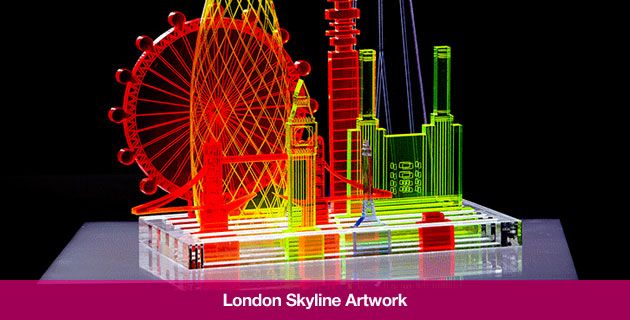ALL ABOUT ACRYLIC FOR YOUR ARTWORK
Acrylic plastic is highly prized for its easy workability and its clarity. In fact, clear acrylic plastic transmits light better than regular glass.
Q: What is acrylic made of?
Acrylic is a transparent thermoplastic known as polyacrylate and is derived from natural-gas. It is a composition of Methyl Methacrylate (MMA) and Poly Methyl Methacrylate (PMMA) resin. In short, it’s a petroleum-based product, so petroleum solvents and chemicals should always be avoided to prevent marking the surface.
Q: What is the difference between acrylic, Plexiglas, Lucite, Perspex, and Lexan or clear plastic?
A: Acrylic (polyacrylate) is marketed under many trade names including Plexiglas, Lucite, Perspex, Policril, Gavrieli, Vitroflex, Limacryl, R-Cast, Per-Clax, Plazcryl, Acrylex, Acrylite, Acrylplast, Altuglas, Polycast, Oroglass, Optix.
These differ from Lexan which is polycarbonate, and is sometimes used as bullet-proof glass. Although it is more shatter-resistant, it is more expensive than acrylic, yellows with prolonged exposure to sunlight, and is much more easily scratched. Therefore acrylic is more ideal for most interior and exterior design purposes.
Clear plastic can refer to a wide range of synthetic compounds, with varying strengths, melting points, and other properties.
Q: How do I clean acrylic?
A: While acrylic softens at higher temperatures, it does not actually melt until it reaches 320 °F (160 °C). Therefore, normal household use does not risk melting acrylic. Hot stovetop items should only be placed on an acrylic tabletop surface using a protective trivet or other padding, preferably with rubber cushions. As a safety precaution, never place acrylic directly on or next to an open flame or hot surface.
Q: Can I bend or reshape acrylic myself?
A: This is not recommended. Acrylic must be heated in order to mold its shape, otherwise it will crack and break into pieces. However, it is flammable at certain temperatures so heating by open flame is not recommended, and other methods of heating may cause it to adhere to the heating device itself. Only professional technicians with the proper tools and safety equipment should attempt to heat and reshape acrylic items.
Q: Is acrylic the same as “bullet-proof” glass?
A: No, bullet-resistant glass is made from polycarbonate. Trade names for the base material include Armormax, Makroclear, Cyrolon, Lexan and Tuffak. Although it is more shatter-resistant, polycarbonate is more expensive than acrylic, yellows with prolonged exposure to sunlight, and is much more easily scratched. Therefore acrylic is the far better material for most interior and exterior design purposes.
Q: Does acrylic ‘outgas’? Is it toxicologically harmful?
No. When used as directed and in ambient temperatures, acrylic does not pose hazardous nor toxicological effects to health. This material has been classified as non-hazardous under OSHA regulations.
HOW TO ORDER
Q: Do you work with Designers, Architects and other trade professionals?
Yes. We offer exclusive discounts for design professionals, including PDF tear-sheets for clients, online trade accounts with access to wholesale pricing and more. Reach out to discover all that we offer.
Q: Do you do custom work?
A: Yes, custom is our specialty! We will work with you taking into consideration your needs, functional requirements and the interior of your home, office, hotel, command space or any individual area.
Q: How does pricing work?
A: We provide custom quotes based on your product selection dimension and thickness. Call us to request your custom quote!
Q: What is your usual turnaround time?
Our products are typically ready from 4 to 8 weeks from date of order. We will provide an estimated completion date at the time of order.
Q: How do I receive my order?
We offer a few options, including FedEx Ground, White Glove, and NYC Metro Delivery. Call us to inquire about your preferred method.
CARING FOR YOUR CUSTOM PLEXI:
Q: How do I clean acrylic?
Acrylic care consists of no more than normal wipe-cleaning to keep it looking new. Chemicals should never be used, and care should be taken to avoid scratches. See our Product Care page for complete recommendations.
Q: How can I remove scratches from acrylic?
A: Removing acrylic scratches (ones that you can see or feel by passing a fingernail over them) can be accomplished by using Novus2 or Novus3 cleaner, depending on the severity of the scratch. These are available on our Product Care page. If your acrylic piece is scored or gouged deeply, contact us for more detailed options that include sanding and refinishing.
Q: Should I keep acrylic out of the sun?
A: Sunlight will not affect your acrylic items. Acrylic is derived from natural gas and is completely inert in its solid form and will NOT yellow in the sunlight. Sunlight, especially ultraviolet radiation, has a negative effect on most plastics, but not acrylic.
Q: Can acrylic be painted?
A: Yes, you can paint acrylic using acrylic paint.
What kind of paint do you use on acrylic plastic?
Spray paint works especially well for plastic, but you can use acrylic or enamel/model paint as well.
Does acrylic paint stay on plastic?
Acrylic paint can be used on plastic, but it is not specifically designed for this use. Acrylics don’t always hold up as well to repeated handling as other paints, and they work better on surfaces that allow air through, like wood and paper, than they do on plastic.
How do you seal acrylic paint on plastic?
A clear acrylic sealer gives your freshly painted plastic surface an extra layer of protection. You don’t have to use the sealer, but it can help the results be more permanent, especially if you’re painting an outdoor item. You can get a spray sealer to make the job easier.
What paint is best to use on plastic?
- Krylon K08974007 SUPERMAXX Spray Paint. …
- Rust-Oleum 249079 Painter’s Touch 2X. …
- Krylon K02422007 Fusion for Plastic. …
- Krylon K04293007 Camouflage With Fusion. …
- Dupli-Color CP199 Clear Adhesion Promoter. …
- Rust-Oleum 211338 Paint For Plastic Spray. …
- SEM Paints SEM15243 Satin.
What paint will adhere to plastic?
Use paints that are specifically formulated to adhere to plastics. There are several available on the market such as Krylon Fusion for Plastic® , Valspar® Plastic Spray Paint , and Rust-Oleum Specialty Paint For Plastic Spray . If using regular spray paint then your item will need to be primed.







